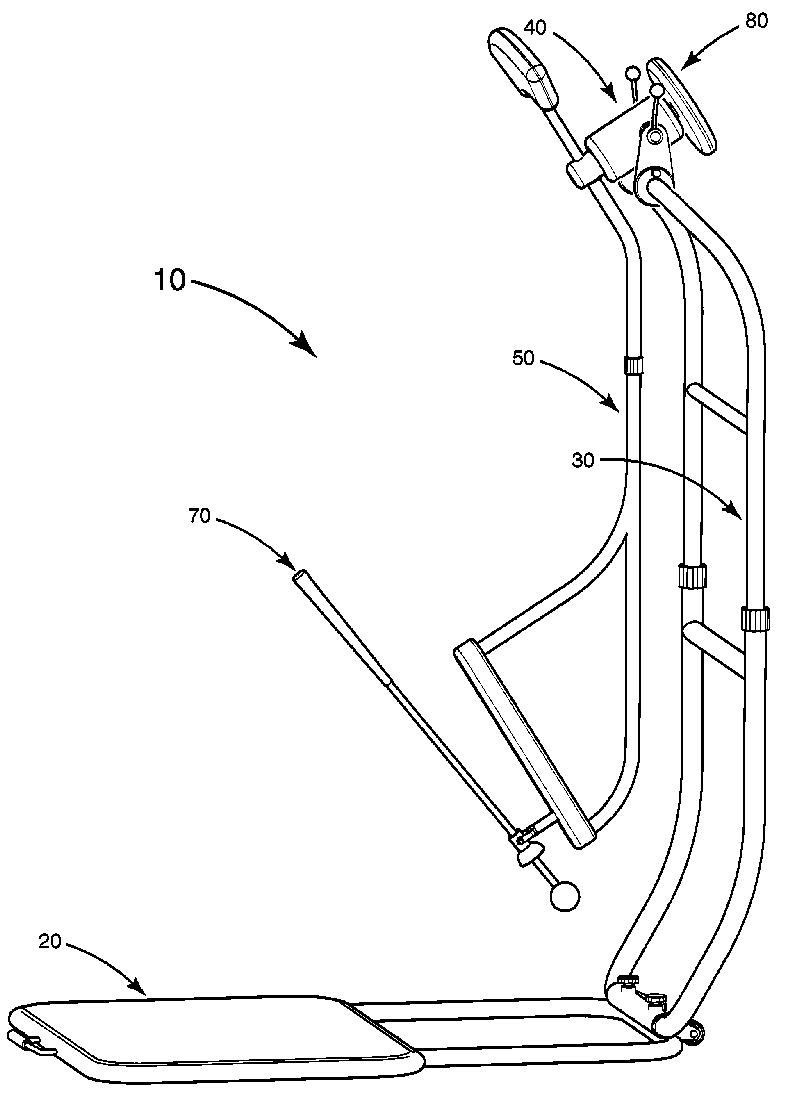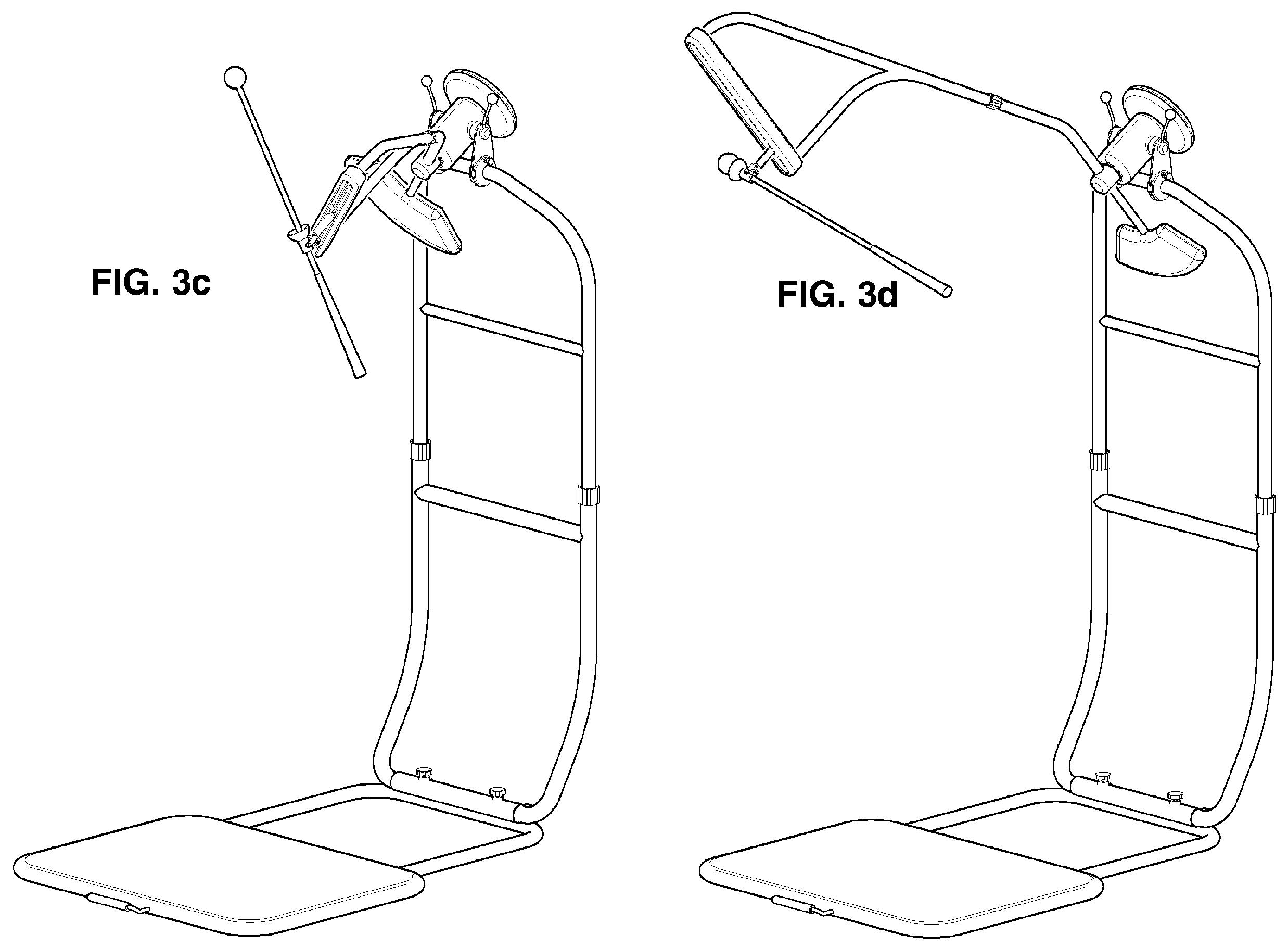Nice Looking Swing Plane Trainer
Check out this nice looking training device.




The figures come from the recently issued patent USPN 7,585,228 titled “Golf Swing Plane Training Device and Method,” which describes the invention as:
A golf swing plane training device is disclosed that helps the user develop a correct swing plane as well as exercise the muscle groups most effective in imparting maximum power to a golf ball. The device is portable and comprises a rotating swing plane guide, one end pivotably connected to a club shaft, for controlling the swing arc of the club shaft when swung by the user to ingrain the feel of swinging on plane. The other end of the rotating swing plane guide is connected to a rotation control assembly mounted on a vertically adjustable support frame. A resistance source is connected to the hub of the rotation control assembly.
The patent goes on to explain:
Golf is a sport that has a centuries-long history and has been studied exhaustively by devoted golfers in their quest to understand and master the fundamentals of the golf swing mechanics. There is a constant stream of instructions in the form of books, videos and magazine articles on various elements of the golf swing, such as grip, stance, posture, steps of the swing (backswing, downswing and follow-through) and swing plane. Likewise, there is also a steady flow of training devices being created to help golfers tackle specific aspects of the golf swing. Of all the elements, the concept of the swing plane may possibly be the most complicated to grasp.
It is generally acknowledged that one must swing “on plane” to produce a good golf shot. However, many golfers do not have a clear understanding of what the swing plane is and what it is that should be on this plane. The primary reason for this difficulty is that a golf swing is a dynamic motion in a three-dimensional space that lasts only a second or two. It is infeasible for a golfer to observe or check his/her own swing plane in real time; the viewing of one’s own swing can only be done using high-speed video or sequence photograph that captures the swing in a two-dimensional space. Furthermore, other referential concepts intended to help golfers gain understanding may be misinterpreted by some. For instance, there is the “shaft plane”, defined as the imaginary line that runs through the club shaft as it sits at address, and the “Hogan plane”, which is an imaginary pane of glass extending from the ball to the golfer’s shoulders. Conceptual planes like these serve as valuable checkpoints of a golfer’s swing at discrete steps; however, they do not describe the plane the club travels on throughout a golf swing.
Put simply, a correct golf swing requires the club shaft be swung on substantially the same plane on both the backswing and the downswing. If one could observe the trail of a marker on the club shaft made during a swing, it would correspond to an elliptical arc. The arc is not circular as the golfer does not pivot around a central point through the entire swing. Hips, arms, elbows, wrists, etc. are all pivot points that are activated at different moments during the swing. Also, this elliptical arc flattens further as the swing approaches the end of the backswing, i.e., the top of the swing. Furthermore, as the downswing is initiated with a slight lower-body shift toward the target coupled with a lowering of the right shoulder and elbow (for a right-handed golfer), the elliptical arc of the downswing, if it could be observed, would be narrower than that of the backswing and likely on a slightly flatter plane. Therefore, a correct golf swing requires the downswing be on the same plane as, or a slightly flatter plane than, that of the backswing. For a normal golf shot, when the golfer is not attempting to shape the ball flight, the downswing should not be on a steeper plane than that of the backswing, which tends to lead to the dreaded “outside-in” move not conducive to a good golf shot.
Finally, there is not a singular “ideal” swing plane that is suitable for all golfers. The plane angle, which is the angle between the swing plane and the ground, varies amongst golfers depending on many factors such as height, body build, arm length proportion, spine tilt at address, etc. Additionally, for each golfer, the plane angle also varies depending on the length of the particular club being used for a golf shot and the position of the ball, i.e., the lie. As to the arc of the swing, it should be narrower on the downswing. However, the degree again differs amongst golfers depending on factors such as the amount of lower-body forward shift, ability to retain a full wrist cock on the downswing, etc. These are natural and perfectly acceptable variations; there is no singular ideal swing that all golfers should be forced to imitate.
Perhaps to a greater extent than other aspects of the golf swing, the golfer must rely on the proper feel, or muscle memory, to keep his/her swing on plane. Even with a sound understanding of the concept, it is difficult for a golfer to work on his/her swing plane without the assistance of an instructor or a training device. Many training devices have been conceived over the years to help golfers “groove” their swing and develop the desired muscle memory. These devices fall generally into three categories. One category of training devices concentrate on constant- or variable-force resistance training of the specific muscles involved in the golf swing (backswing, downswing or follow-through), and secondarily on swing plane training. Most of these devices employ a handle connected to a flexible cord which, in turn, is connected to a resistance mechanism. The resistance force discourages, but not constrains, the user from making an abrupt, jerky movement when transitioning from backswing to downswing. Also, the flexible cord exerts little control over the path of the movement of hands or the swing plane. A second category of training devices use tracks or rails to lay out a predetermined, fixed path for a real or simulated golf club. Some devices mandate the exact same plane for both the backswing and the downswing. Others construct a narrower or flatter, but fixed and non-adjustable, path for the downswing. That is to say, most of these devices do not take into account the perfectly allowable variations in golfers’ swings. Also, these devices are outsized, difficult to transport, and tend to be expensive to manufacture.
.
.
.
.
.The present invention relates to a golf swing plane training device that also serves as an exercising device to help the user develop the muscle memory of swinging on plane as well as exercise the muscle groups most effective in imparting maximum power to a golf ball. The device is portable and comprises a rotating swing plane guide, one end pivotably connected to a golf club shaft, for constraining and controlling the swing arc of the golf club shaft when swung by the user to ingrain the feel of swinging on plane and consequently develop a correct golf swing. The other end of the rotating swing plane guide is connected to a rotation control assembly. A resistance source is connected to the hub of the rotation control assembly to provide resistance force against the club shaft on the downswing, strengthening the muscle groups that need be activated to maximize power and intensifying the proper feel of a correct swing.
One object of the present invention provides a golf swing plane training device that is relatively compact is size and is realistically portable.
The device is collapsible; it can be set up at a suitable location for a practice session, and then folded into a storage configuration.Another object of the present invention provides a golf swing plane training device that includes a rotation control assembly mounted on a vertically adjustable support frame. The rotation control assembly is set at an angle that is adjustable, but fixed during operation. This angle determines the axis of rotation and, thus, the angle of the swing plane. The adjustability of the height of the device and the plane angle allows the device to be used by all golfers.
A further object of the present invention provides a golf swing plane training device having a swing plane guide which comprises a rotatable, largely concave swing arm to constrain and restrict the club shaft from moving down on a swing plane steeper than that of the backswing. The curved shape of the swing plane guide allows it to clear the user’s head when the swing is approaching the top of the swing or the end of the follow-through. The swing plane guide further comprises a radius adjustment assembly, connected to the swing arm, which includes a linear track having an axis perpendicular to the swing plane axis of rotation. A universal pivoting assembly is employed to connect a golf club shaft to the swing arm via a carriage slidably disposed on the linear track. Thus, the golf club shaft is not connected to the swing plane guide at a fixed point, which would force the golf club shaft to follow a circular swing arc. The connecting point is at the carriage which is free to slide along the linear track, and the golf club shaft can follow a swing arc that flattens toward the top of the swing.
Still a further object of the present invention provides a golf swing plane training device that employs a universal joint for connecting the golf club shaft to the swing plane guide, allowing the club shaft to pivot freely relative to the swing plane guide and to slide within the universal joint. Hence, the swing arc is not limited to strictly follow a circular shape, and the swing arc can be extended on the backswing and narrowed on the downswing by varying degrees as is natural to different golfers. Furthermore, the radius adjustment assembly includes a swing plane varying assembly which extends and retracts axially, allowing the user to initiate the downswing on a slightly flatter swing plane.
Yet one further object of the present invention provides a golf swing plane training device that contains a resistance source for exercising the muscle groups which are most effective in transferring maximum power to a golf ball. The resistance force preferably is only engaged on the downswing and is disengaged on the backswing, as the goal during the backswing is to achieve smooth motion and full extension in order to maximize leverage.
Pretty cool. I would like to have one of these in the basement (or office).
Dave Dawsey – Tracking Golf Training Inventions
PS – click HERE to check out interesting putter posts
